Queensland Cotton: Report on Business Level Strategy and Analysis
VerifiedAdded on 2023/01/19
|35
|8493
|33
Report
AI Summary
This report provides an in-depth analysis of Queensland Cotton, a leading Australian cotton marketing and ginning organization. It examines the company's business units, product lines, and revenue streams, highlighting the importance of its largest revenue units. The report delves into Queensland Cotton's business-level strategies, including cost leadership, differentiation, and integrated approaches, and analyzes its model of competitive reality within the Australian cotton industry. Furthermore, it outlines an implementation plan, an evaluation strategy, and offers recommendations for the future strategic direction of Queensland Cotton. The analysis covers the Australian Stock Exchange's impact, seasonal conditions, and cotton production statistics, providing a comprehensive overview of the company's operations and strategic positioning within the agribusiness sector. The report also references the Cotton Research and Development Corporation (CRDC) and its strategic plan for the cotton industry.
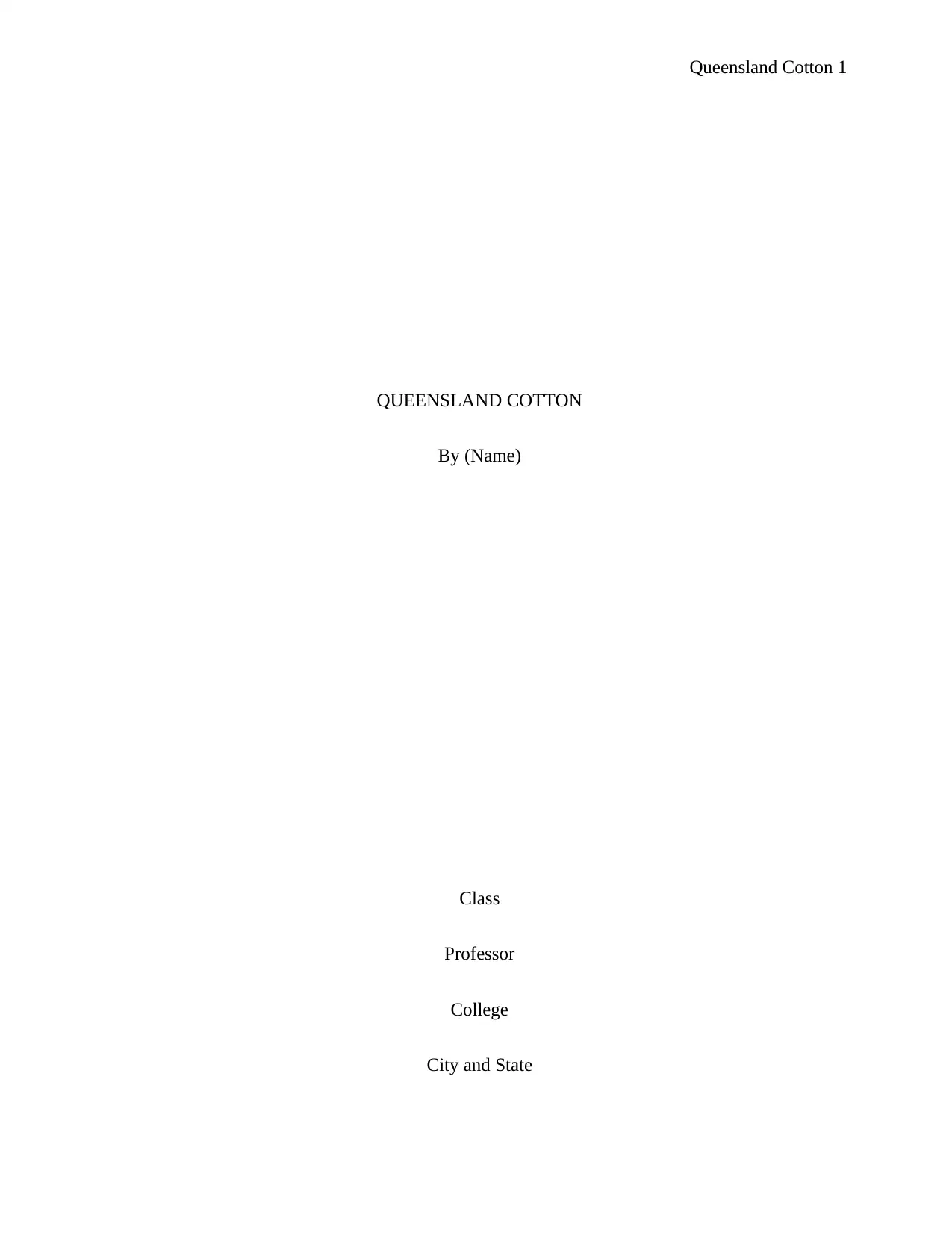
Queensland Cotton 1
QUEENSLAND COTTON
By (Name)
Class
Professor
College
City and State
QUEENSLAND COTTON
By (Name)
Class
Professor
College
City and State
Paraphrase This Document
Need a fresh take? Get an instant paraphrase of this document with our AI Paraphraser
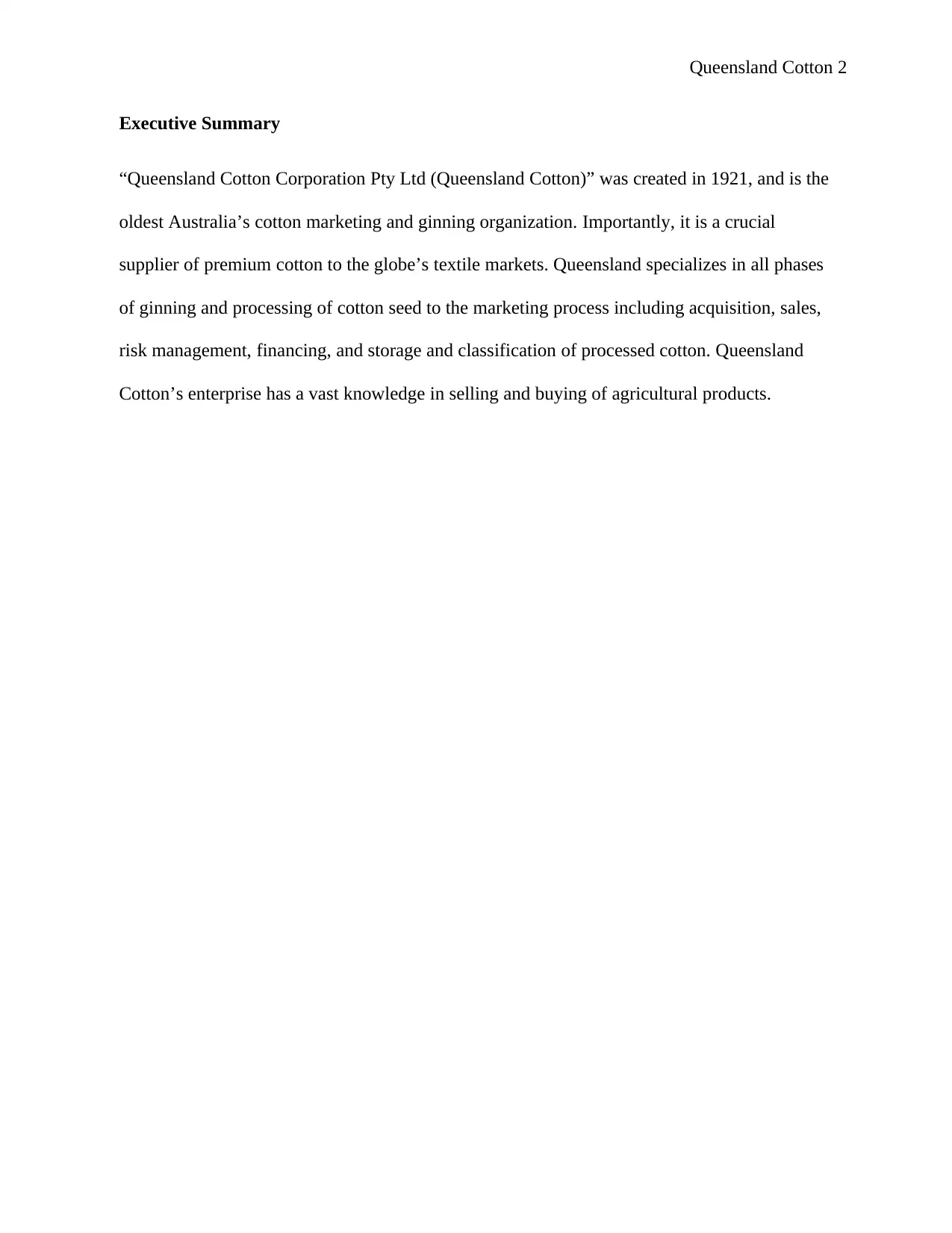
Queensland Cotton 2
Executive Summary
“Queensland Cotton Corporation Pty Ltd (Queensland Cotton)” was created in 1921, and is the
oldest Australia’s cotton marketing and ginning organization. Importantly, it is a crucial
supplier of premium cotton to the globe’s textile markets. Queensland specializes in all phases
of ginning and processing of cotton seed to the marketing process including acquisition, sales,
risk management, financing, and storage and classification of processed cotton. Queensland
Cotton’s enterprise has a vast knowledge in selling and buying of agricultural products.
Executive Summary
“Queensland Cotton Corporation Pty Ltd (Queensland Cotton)” was created in 1921, and is the
oldest Australia’s cotton marketing and ginning organization. Importantly, it is a crucial
supplier of premium cotton to the globe’s textile markets. Queensland specializes in all phases
of ginning and processing of cotton seed to the marketing process including acquisition, sales,
risk management, financing, and storage and classification of processed cotton. Queensland
Cotton’s enterprise has a vast knowledge in selling and buying of agricultural products.
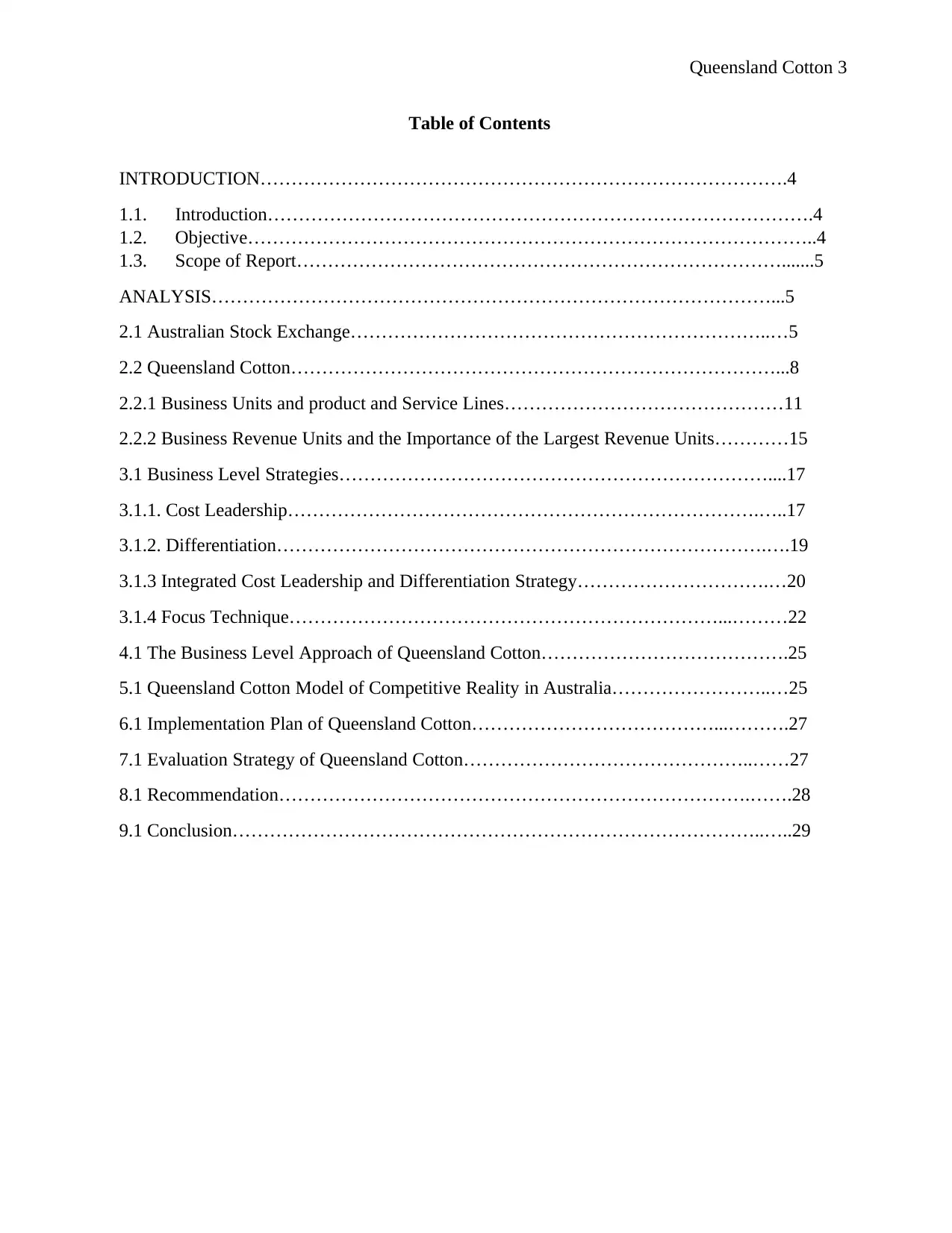
Queensland Cotton 3
Table of Contents
INTRODUCTION………………………………………………………………………….4
1.1. Introduction…………………………………………………………………………….4
1.2. Objective………………………………………………………………………………..4
1.3. Scope of Report…………………………………………………………………….......5
ANALYSIS………………………………………………………………………………...5
2.1 Australian Stock Exchange…………………………………………………………..…5
2.2 Queensland Cotton……………………………………………………………………...8
2.2.1 Business Units and product and Service Lines………………………………………11
2.2.2 Business Revenue Units and the Importance of the Largest Revenue Units…………15
3.1 Business Level Strategies……………………………………………………………....17
3.1.1. Cost Leadership………………………………………………………………….…..17
3.1.2. Differentiation…………………………………………………………………….….19
3.1.3 Integrated Cost Leadership and Differentiation Strategy………………………….…20
3.1.4 Focus Technique……………………………………………………………...………22
4.1 The Business Level Approach of Queensland Cotton………………………………….25
5.1 Queensland Cotton Model of Competitive Reality in Australia……………………..…25
6.1 Implementation Plan of Queensland Cotton…………………………………...……….27
7.1 Evaluation Strategy of Queensland Cotton………………………………………..……27
8.1 Recommendation………………………………………………………………….…….28
9.1 Conclusion…………………………………………………………………………..…..29
Table of Contents
INTRODUCTION………………………………………………………………………….4
1.1. Introduction…………………………………………………………………………….4
1.2. Objective………………………………………………………………………………..4
1.3. Scope of Report…………………………………………………………………….......5
ANALYSIS………………………………………………………………………………...5
2.1 Australian Stock Exchange…………………………………………………………..…5
2.2 Queensland Cotton……………………………………………………………………...8
2.2.1 Business Units and product and Service Lines………………………………………11
2.2.2 Business Revenue Units and the Importance of the Largest Revenue Units…………15
3.1 Business Level Strategies……………………………………………………………....17
3.1.1. Cost Leadership………………………………………………………………….…..17
3.1.2. Differentiation…………………………………………………………………….….19
3.1.3 Integrated Cost Leadership and Differentiation Strategy………………………….…20
3.1.4 Focus Technique……………………………………………………………...………22
4.1 The Business Level Approach of Queensland Cotton………………………………….25
5.1 Queensland Cotton Model of Competitive Reality in Australia……………………..…25
6.1 Implementation Plan of Queensland Cotton…………………………………...……….27
7.1 Evaluation Strategy of Queensland Cotton………………………………………..……27
8.1 Recommendation………………………………………………………………….…….28
9.1 Conclusion…………………………………………………………………………..…..29
⊘ This is a preview!⊘
Do you want full access?
Subscribe today to unlock all pages.

Trusted by 1+ million students worldwide
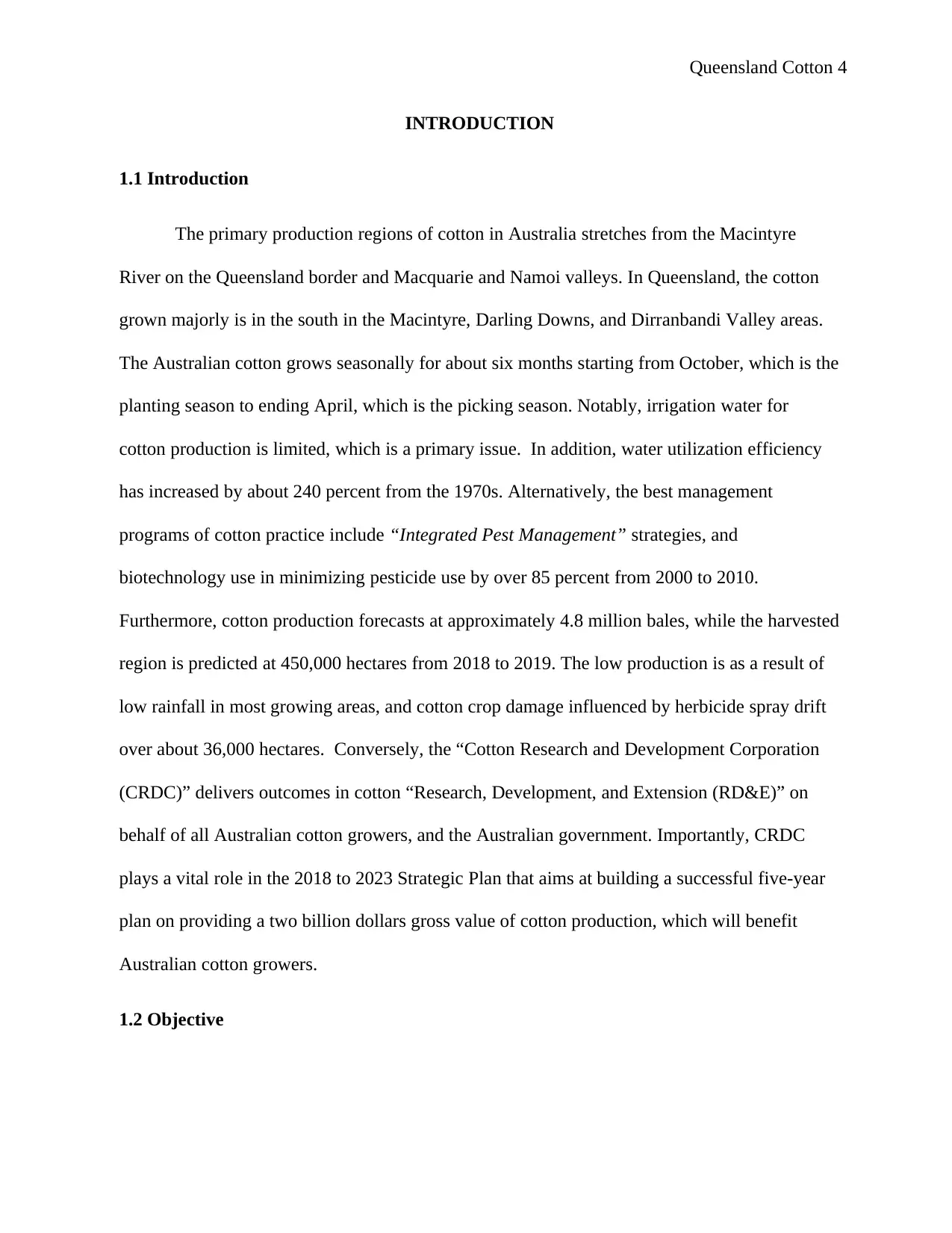
Queensland Cotton 4
INTRODUCTION
1.1 Introduction
The primary production regions of cotton in Australia stretches from the Macintyre
River on the Queensland border and Macquarie and Namoi valleys. In Queensland, the cotton
grown majorly is in the south in the Macintyre, Darling Downs, and Dirranbandi Valley areas.
The Australian cotton grows seasonally for about six months starting from October, which is the
planting season to ending April, which is the picking season. Notably, irrigation water for
cotton production is limited, which is a primary issue. In addition, water utilization efficiency
has increased by about 240 percent from the 1970s. Alternatively, the best management
programs of cotton practice include “Integrated Pest Management” strategies, and
biotechnology use in minimizing pesticide use by over 85 percent from 2000 to 2010.
Furthermore, cotton production forecasts at approximately 4.8 million bales, while the harvested
region is predicted at 450,000 hectares from 2018 to 2019. The low production is as a result of
low rainfall in most growing areas, and cotton crop damage influenced by herbicide spray drift
over about 36,000 hectares. Conversely, the “Cotton Research and Development Corporation
(CRDC)” delivers outcomes in cotton “Research, Development, and Extension (RD&E)” on
behalf of all Australian cotton growers, and the Australian government. Importantly, CRDC
plays a vital role in the 2018 to 2023 Strategic Plan that aims at building a successful five-year
plan on providing a two billion dollars gross value of cotton production, which will benefit
Australian cotton growers.
1.2 Objective
INTRODUCTION
1.1 Introduction
The primary production regions of cotton in Australia stretches from the Macintyre
River on the Queensland border and Macquarie and Namoi valleys. In Queensland, the cotton
grown majorly is in the south in the Macintyre, Darling Downs, and Dirranbandi Valley areas.
The Australian cotton grows seasonally for about six months starting from October, which is the
planting season to ending April, which is the picking season. Notably, irrigation water for
cotton production is limited, which is a primary issue. In addition, water utilization efficiency
has increased by about 240 percent from the 1970s. Alternatively, the best management
programs of cotton practice include “Integrated Pest Management” strategies, and
biotechnology use in minimizing pesticide use by over 85 percent from 2000 to 2010.
Furthermore, cotton production forecasts at approximately 4.8 million bales, while the harvested
region is predicted at 450,000 hectares from 2018 to 2019. The low production is as a result of
low rainfall in most growing areas, and cotton crop damage influenced by herbicide spray drift
over about 36,000 hectares. Conversely, the “Cotton Research and Development Corporation
(CRDC)” delivers outcomes in cotton “Research, Development, and Extension (RD&E)” on
behalf of all Australian cotton growers, and the Australian government. Importantly, CRDC
plays a vital role in the 2018 to 2023 Strategic Plan that aims at building a successful five-year
plan on providing a two billion dollars gross value of cotton production, which will benefit
Australian cotton growers.
1.2 Objective
Paraphrase This Document
Need a fresh take? Get an instant paraphrase of this document with our AI Paraphraser
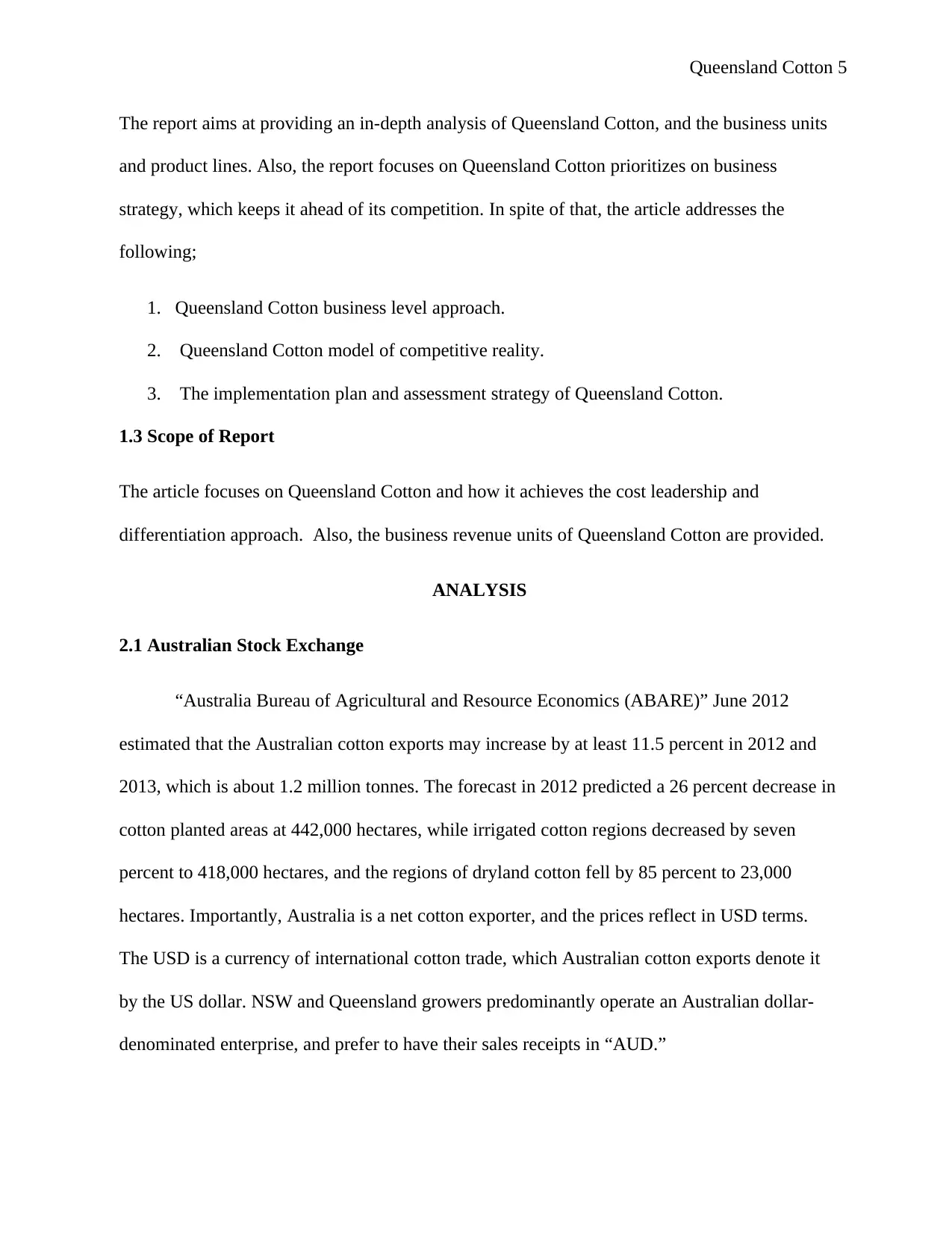
Queensland Cotton 5
The report aims at providing an in-depth analysis of Queensland Cotton, and the business units
and product lines. Also, the report focuses on Queensland Cotton prioritizes on business
strategy, which keeps it ahead of its competition. In spite of that, the article addresses the
following;
1. Queensland Cotton business level approach.
2. Queensland Cotton model of competitive reality.
3. The implementation plan and assessment strategy of Queensland Cotton.
1.3 Scope of Report
The article focuses on Queensland Cotton and how it achieves the cost leadership and
differentiation approach. Also, the business revenue units of Queensland Cotton are provided.
ANALYSIS
2.1 Australian Stock Exchange
“Australia Bureau of Agricultural and Resource Economics (ABARE)” June 2012
estimated that the Australian cotton exports may increase by at least 11.5 percent in 2012 and
2013, which is about 1.2 million tonnes. The forecast in 2012 predicted a 26 percent decrease in
cotton planted areas at 442,000 hectares, while irrigated cotton regions decreased by seven
percent to 418,000 hectares, and the regions of dryland cotton fell by 85 percent to 23,000
hectares. Importantly, Australia is a net cotton exporter, and the prices reflect in USD terms.
The USD is a currency of international cotton trade, which Australian cotton exports denote it
by the US dollar. NSW and Queensland growers predominantly operate an Australian dollar-
denominated enterprise, and prefer to have their sales receipts in “AUD.”
The report aims at providing an in-depth analysis of Queensland Cotton, and the business units
and product lines. Also, the report focuses on Queensland Cotton prioritizes on business
strategy, which keeps it ahead of its competition. In spite of that, the article addresses the
following;
1. Queensland Cotton business level approach.
2. Queensland Cotton model of competitive reality.
3. The implementation plan and assessment strategy of Queensland Cotton.
1.3 Scope of Report
The article focuses on Queensland Cotton and how it achieves the cost leadership and
differentiation approach. Also, the business revenue units of Queensland Cotton are provided.
ANALYSIS
2.1 Australian Stock Exchange
“Australia Bureau of Agricultural and Resource Economics (ABARE)” June 2012
estimated that the Australian cotton exports may increase by at least 11.5 percent in 2012 and
2013, which is about 1.2 million tonnes. The forecast in 2012 predicted a 26 percent decrease in
cotton planted areas at 442,000 hectares, while irrigated cotton regions decreased by seven
percent to 418,000 hectares, and the regions of dryland cotton fell by 85 percent to 23,000
hectares. Importantly, Australia is a net cotton exporter, and the prices reflect in USD terms.
The USD is a currency of international cotton trade, which Australian cotton exports denote it
by the US dollar. NSW and Queensland growers predominantly operate an Australian dollar-
denominated enterprise, and prefer to have their sales receipts in “AUD.”
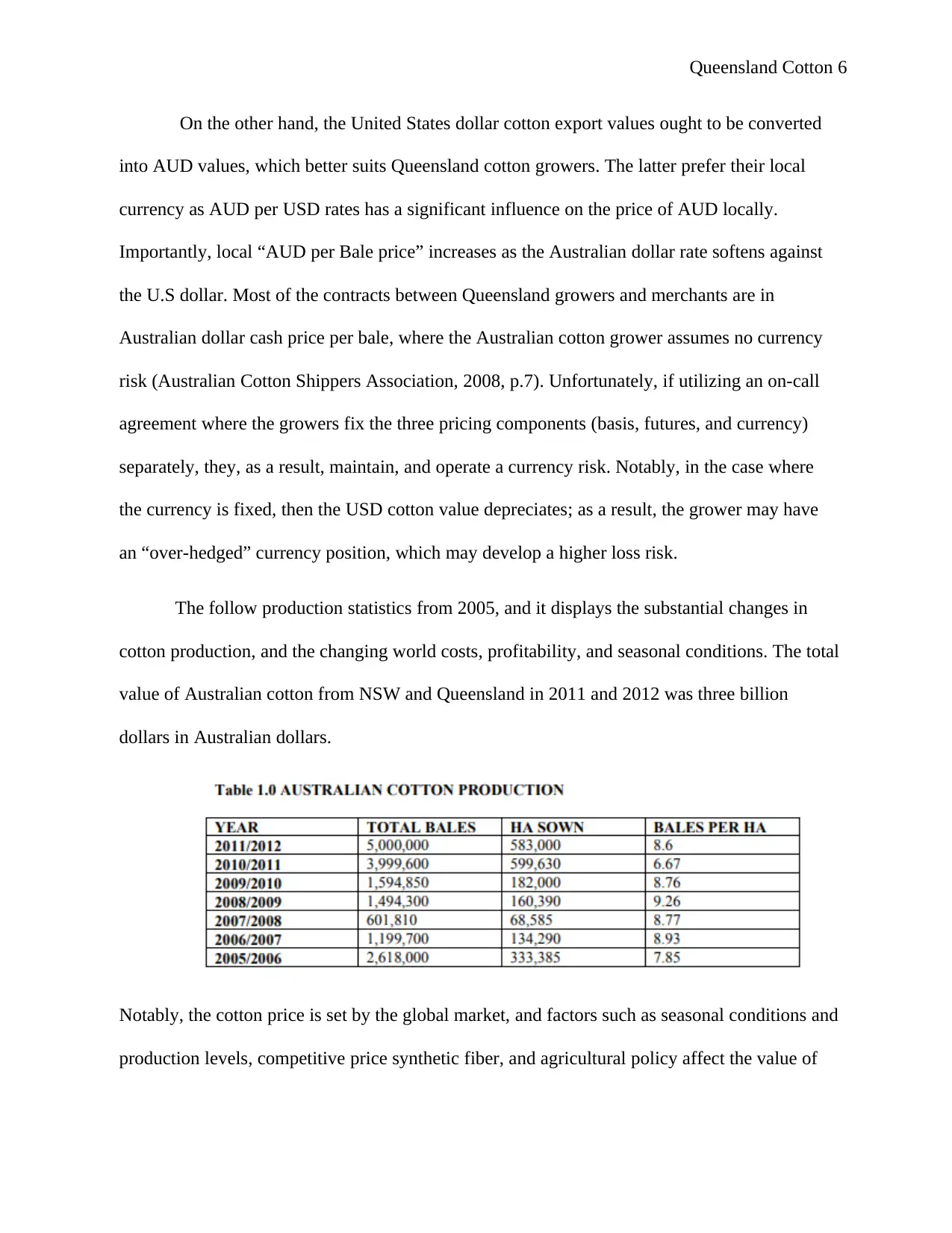
Queensland Cotton 6
On the other hand, the United States dollar cotton export values ought to be converted
into AUD values, which better suits Queensland cotton growers. The latter prefer their local
currency as AUD per USD rates has a significant influence on the price of AUD locally.
Importantly, local “AUD per Bale price” increases as the Australian dollar rate softens against
the U.S dollar. Most of the contracts between Queensland growers and merchants are in
Australian dollar cash price per bale, where the Australian cotton grower assumes no currency
risk (Australian Cotton Shippers Association, 2008, p.7). Unfortunately, if utilizing an on-call
agreement where the growers fix the three pricing components (basis, futures, and currency)
separately, they, as a result, maintain, and operate a currency risk. Notably, in the case where
the currency is fixed, then the USD cotton value depreciates; as a result, the grower may have
an “over-hedged” currency position, which may develop a higher loss risk.
The follow production statistics from 2005, and it displays the substantial changes in
cotton production, and the changing world costs, profitability, and seasonal conditions. The total
value of Australian cotton from NSW and Queensland in 2011 and 2012 was three billion
dollars in Australian dollars.
Notably, the cotton price is set by the global market, and factors such as seasonal conditions and
production levels, competitive price synthetic fiber, and agricultural policy affect the value of
On the other hand, the United States dollar cotton export values ought to be converted
into AUD values, which better suits Queensland cotton growers. The latter prefer their local
currency as AUD per USD rates has a significant influence on the price of AUD locally.
Importantly, local “AUD per Bale price” increases as the Australian dollar rate softens against
the U.S dollar. Most of the contracts between Queensland growers and merchants are in
Australian dollar cash price per bale, where the Australian cotton grower assumes no currency
risk (Australian Cotton Shippers Association, 2008, p.7). Unfortunately, if utilizing an on-call
agreement where the growers fix the three pricing components (basis, futures, and currency)
separately, they, as a result, maintain, and operate a currency risk. Notably, in the case where
the currency is fixed, then the USD cotton value depreciates; as a result, the grower may have
an “over-hedged” currency position, which may develop a higher loss risk.
The follow production statistics from 2005, and it displays the substantial changes in
cotton production, and the changing world costs, profitability, and seasonal conditions. The total
value of Australian cotton from NSW and Queensland in 2011 and 2012 was three billion
dollars in Australian dollars.
Notably, the cotton price is set by the global market, and factors such as seasonal conditions and
production levels, competitive price synthetic fiber, and agricultural policy affect the value of
⊘ This is a preview!⊘
Do you want full access?
Subscribe today to unlock all pages.

Trusted by 1+ million students worldwide
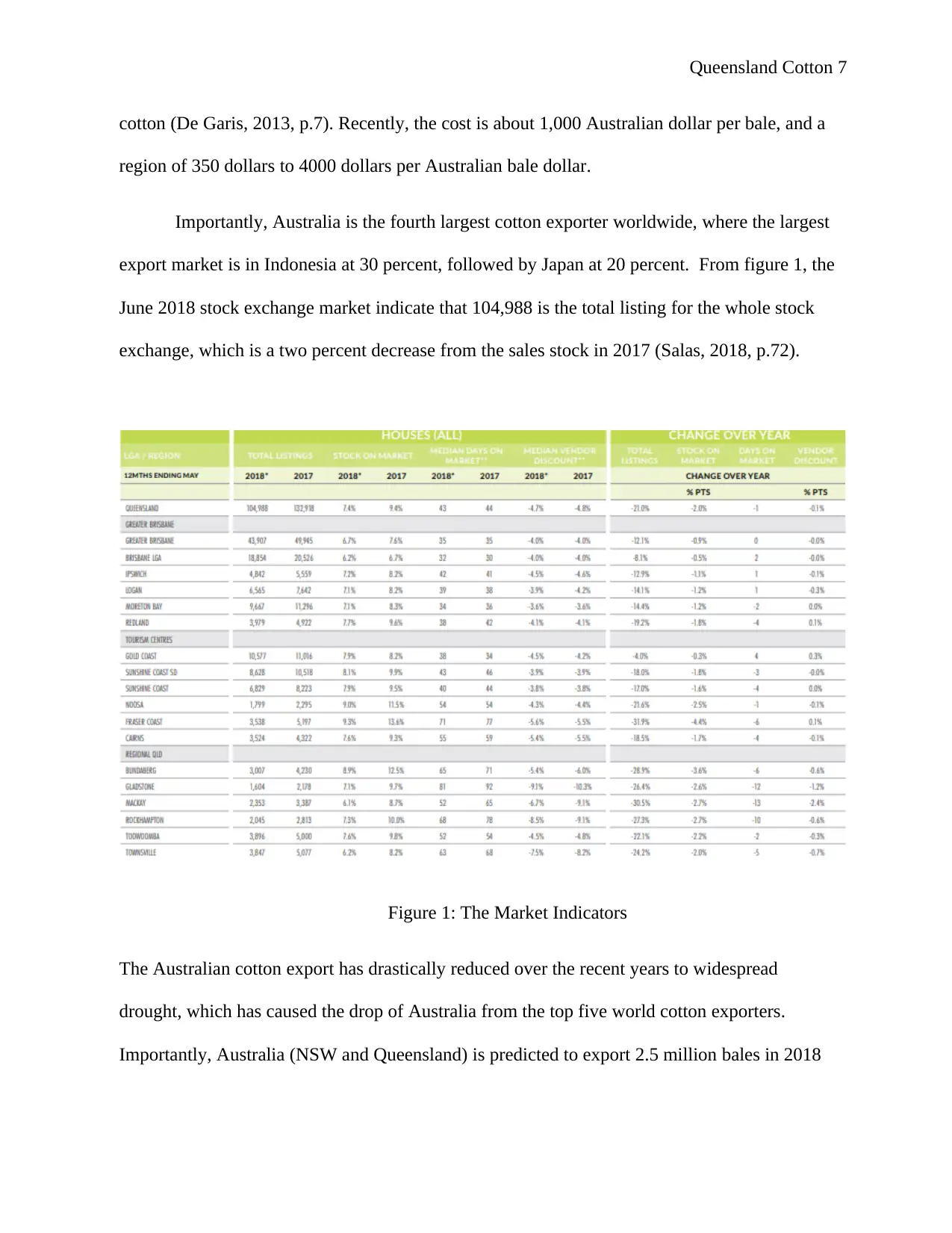
Queensland Cotton 7
cotton (De Garis, 2013, p.7). Recently, the cost is about 1,000 Australian dollar per bale, and a
region of 350 dollars to 4000 dollars per Australian bale dollar.
Importantly, Australia is the fourth largest cotton exporter worldwide, where the largest
export market is in Indonesia at 30 percent, followed by Japan at 20 percent. From figure 1, the
June 2018 stock exchange market indicate that 104,988 is the total listing for the whole stock
exchange, which is a two percent decrease from the sales stock in 2017 (Salas, 2018, p.72).
Figure 1: The Market Indicators
The Australian cotton export has drastically reduced over the recent years to widespread
drought, which has caused the drop of Australia from the top five world cotton exporters.
Importantly, Australia (NSW and Queensland) is predicted to export 2.5 million bales in 2018
cotton (De Garis, 2013, p.7). Recently, the cost is about 1,000 Australian dollar per bale, and a
region of 350 dollars to 4000 dollars per Australian bale dollar.
Importantly, Australia is the fourth largest cotton exporter worldwide, where the largest
export market is in Indonesia at 30 percent, followed by Japan at 20 percent. From figure 1, the
June 2018 stock exchange market indicate that 104,988 is the total listing for the whole stock
exchange, which is a two percent decrease from the sales stock in 2017 (Salas, 2018, p.72).
Figure 1: The Market Indicators
The Australian cotton export has drastically reduced over the recent years to widespread
drought, which has caused the drop of Australia from the top five world cotton exporters.
Importantly, Australia (NSW and Queensland) is predicted to export 2.5 million bales in 2018
Paraphrase This Document
Need a fresh take? Get an instant paraphrase of this document with our AI Paraphraser
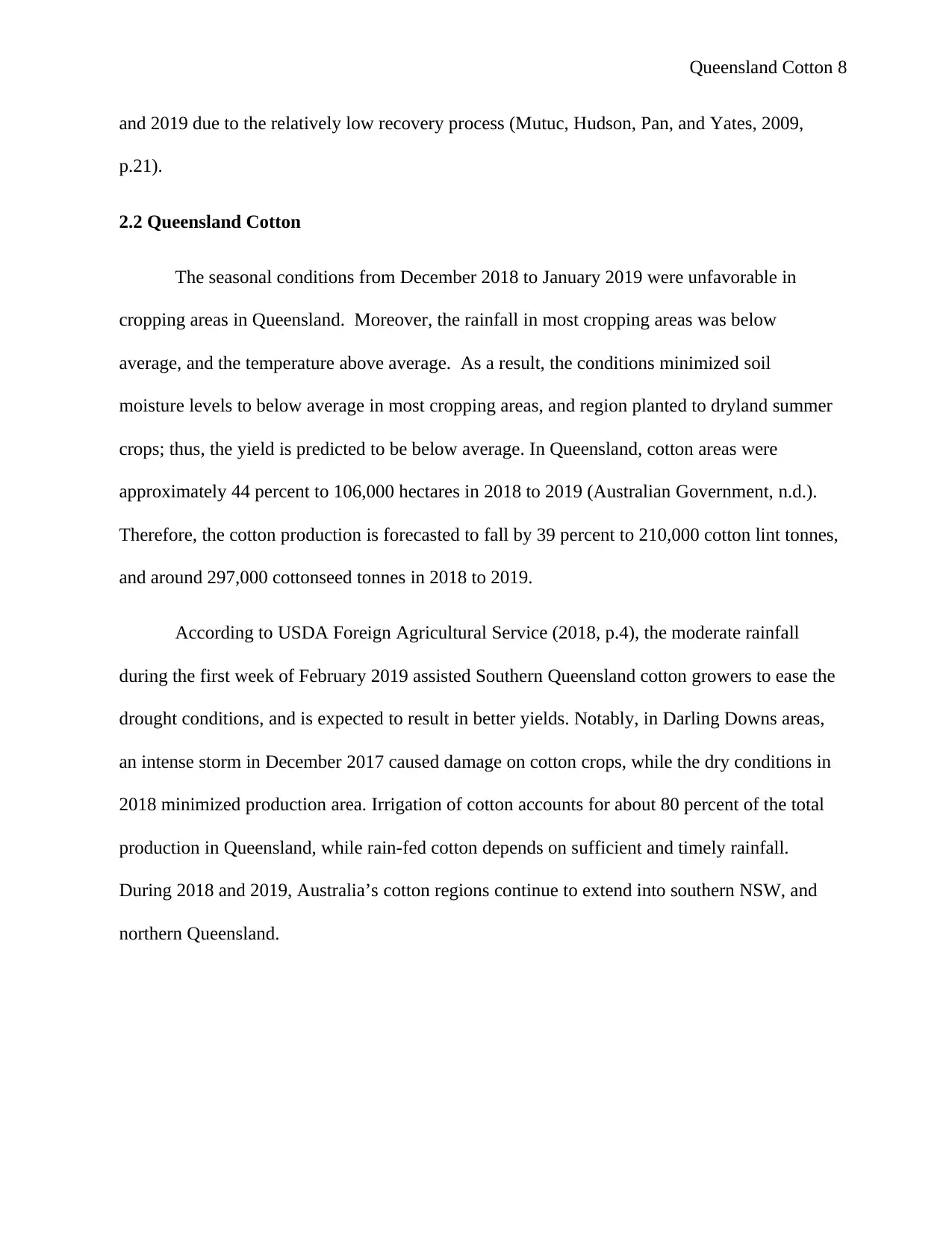
Queensland Cotton 8
and 2019 due to the relatively low recovery process (Mutuc, Hudson, Pan, and Yates, 2009,
p.21).
2.2 Queensland Cotton
The seasonal conditions from December 2018 to January 2019 were unfavorable in
cropping areas in Queensland. Moreover, the rainfall in most cropping areas was below
average, and the temperature above average. As a result, the conditions minimized soil
moisture levels to below average in most cropping areas, and region planted to dryland summer
crops; thus, the yield is predicted to be below average. In Queensland, cotton areas were
approximately 44 percent to 106,000 hectares in 2018 to 2019 (Australian Government, n.d.).
Therefore, the cotton production is forecasted to fall by 39 percent to 210,000 cotton lint tonnes,
and around 297,000 cottonseed tonnes in 2018 to 2019.
According to USDA Foreign Agricultural Service (2018, p.4), the moderate rainfall
during the first week of February 2019 assisted Southern Queensland cotton growers to ease the
drought conditions, and is expected to result in better yields. Notably, in Darling Downs areas,
an intense storm in December 2017 caused damage on cotton crops, while the dry conditions in
2018 minimized production area. Irrigation of cotton accounts for about 80 percent of the total
production in Queensland, while rain-fed cotton depends on sufficient and timely rainfall.
During 2018 and 2019, Australia’s cotton regions continue to extend into southern NSW, and
northern Queensland.
and 2019 due to the relatively low recovery process (Mutuc, Hudson, Pan, and Yates, 2009,
p.21).
2.2 Queensland Cotton
The seasonal conditions from December 2018 to January 2019 were unfavorable in
cropping areas in Queensland. Moreover, the rainfall in most cropping areas was below
average, and the temperature above average. As a result, the conditions minimized soil
moisture levels to below average in most cropping areas, and region planted to dryland summer
crops; thus, the yield is predicted to be below average. In Queensland, cotton areas were
approximately 44 percent to 106,000 hectares in 2018 to 2019 (Australian Government, n.d.).
Therefore, the cotton production is forecasted to fall by 39 percent to 210,000 cotton lint tonnes,
and around 297,000 cottonseed tonnes in 2018 to 2019.
According to USDA Foreign Agricultural Service (2018, p.4), the moderate rainfall
during the first week of February 2019 assisted Southern Queensland cotton growers to ease the
drought conditions, and is expected to result in better yields. Notably, in Darling Downs areas,
an intense storm in December 2017 caused damage on cotton crops, while the dry conditions in
2018 minimized production area. Irrigation of cotton accounts for about 80 percent of the total
production in Queensland, while rain-fed cotton depends on sufficient and timely rainfall.
During 2018 and 2019, Australia’s cotton regions continue to extend into southern NSW, and
northern Queensland.
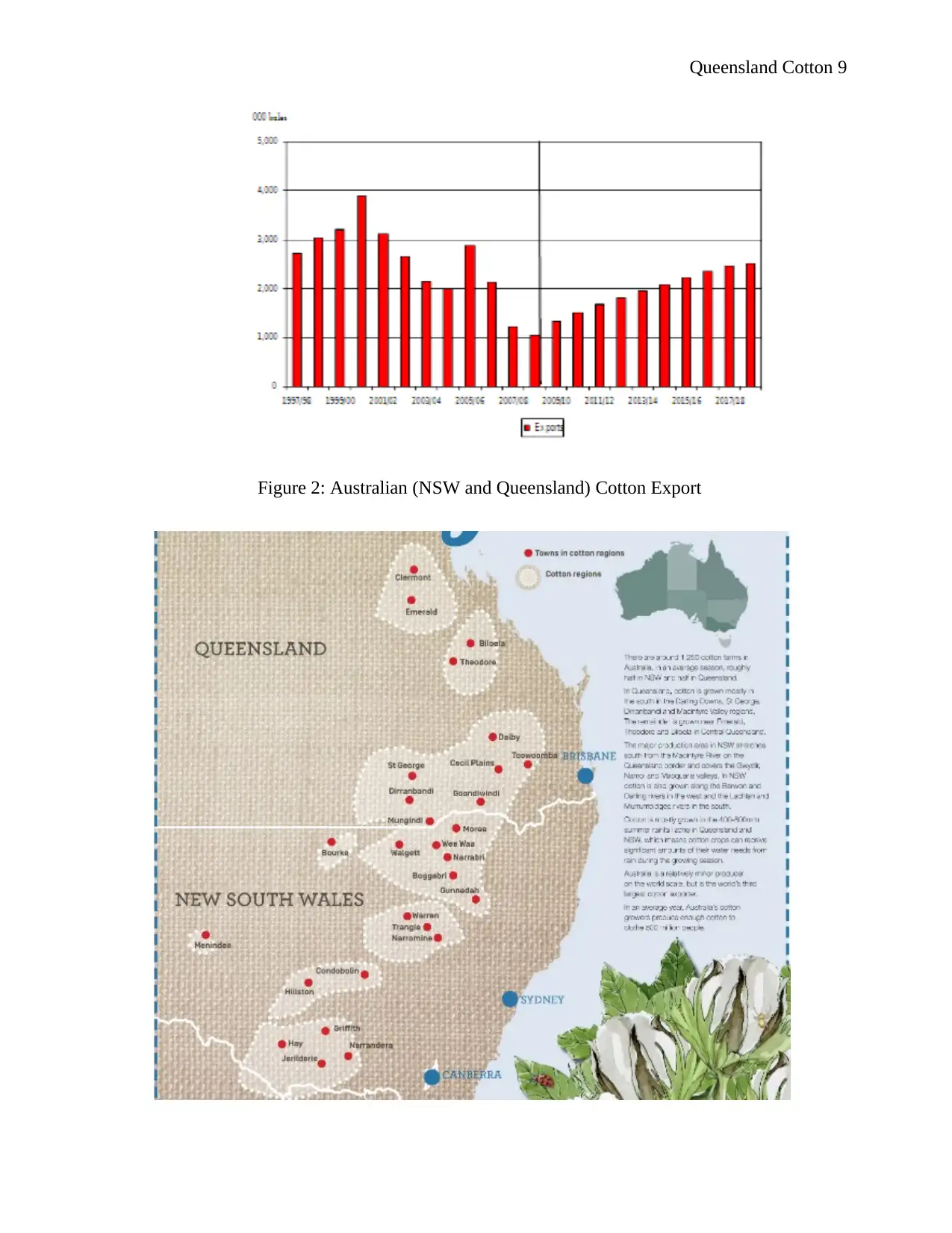
Queensland Cotton 9
Figure 2: Australian (NSW and Queensland) Cotton Export
Figure 2: Australian (NSW and Queensland) Cotton Export
⊘ This is a preview!⊘
Do you want full access?
Subscribe today to unlock all pages.

Trusted by 1+ million students worldwide
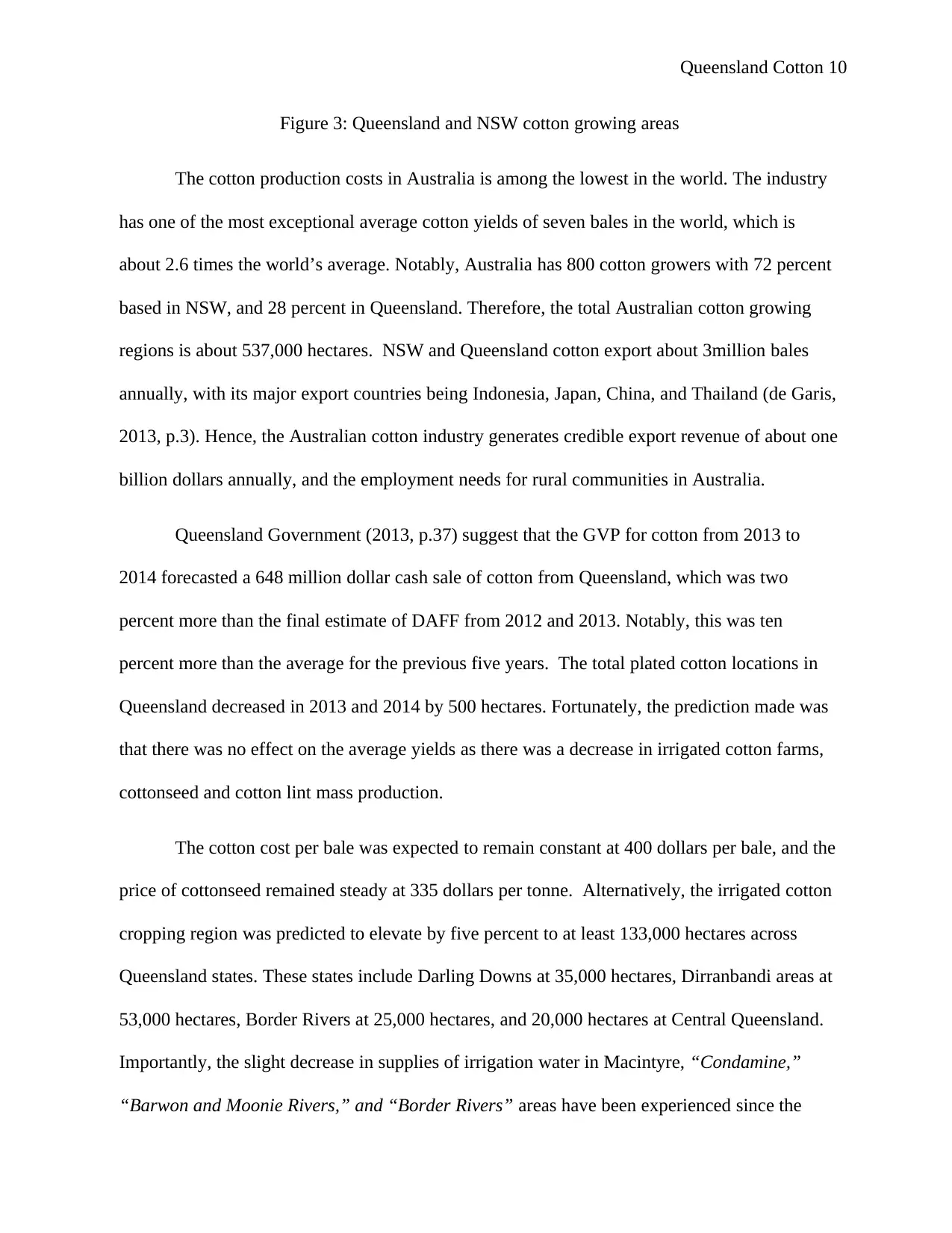
Queensland Cotton 10
Figure 3: Queensland and NSW cotton growing areas
The cotton production costs in Australia is among the lowest in the world. The industry
has one of the most exceptional average cotton yields of seven bales in the world, which is
about 2.6 times the world’s average. Notably, Australia has 800 cotton growers with 72 percent
based in NSW, and 28 percent in Queensland. Therefore, the total Australian cotton growing
regions is about 537,000 hectares. NSW and Queensland cotton export about 3million bales
annually, with its major export countries being Indonesia, Japan, China, and Thailand (de Garis,
2013, p.3). Hence, the Australian cotton industry generates credible export revenue of about one
billion dollars annually, and the employment needs for rural communities in Australia.
Queensland Government (2013, p.37) suggest that the GVP for cotton from 2013 to
2014 forecasted a 648 million dollar cash sale of cotton from Queensland, which was two
percent more than the final estimate of DAFF from 2012 and 2013. Notably, this was ten
percent more than the average for the previous five years. The total plated cotton locations in
Queensland decreased in 2013 and 2014 by 500 hectares. Fortunately, the prediction made was
that there was no effect on the average yields as there was a decrease in irrigated cotton farms,
cottonseed and cotton lint mass production.
The cotton cost per bale was expected to remain constant at 400 dollars per bale, and the
price of cottonseed remained steady at 335 dollars per tonne. Alternatively, the irrigated cotton
cropping region was predicted to elevate by five percent to at least 133,000 hectares across
Queensland states. These states include Darling Downs at 35,000 hectares, Dirranbandi areas at
53,000 hectares, Border Rivers at 25,000 hectares, and 20,000 hectares at Central Queensland.
Importantly, the slight decrease in supplies of irrigation water in Macintyre, “Condamine,”
“Barwon and Moonie Rivers,” and “Border Rivers” areas have been experienced since the
Figure 3: Queensland and NSW cotton growing areas
The cotton production costs in Australia is among the lowest in the world. The industry
has one of the most exceptional average cotton yields of seven bales in the world, which is
about 2.6 times the world’s average. Notably, Australia has 800 cotton growers with 72 percent
based in NSW, and 28 percent in Queensland. Therefore, the total Australian cotton growing
regions is about 537,000 hectares. NSW and Queensland cotton export about 3million bales
annually, with its major export countries being Indonesia, Japan, China, and Thailand (de Garis,
2013, p.3). Hence, the Australian cotton industry generates credible export revenue of about one
billion dollars annually, and the employment needs for rural communities in Australia.
Queensland Government (2013, p.37) suggest that the GVP for cotton from 2013 to
2014 forecasted a 648 million dollar cash sale of cotton from Queensland, which was two
percent more than the final estimate of DAFF from 2012 and 2013. Notably, this was ten
percent more than the average for the previous five years. The total plated cotton locations in
Queensland decreased in 2013 and 2014 by 500 hectares. Fortunately, the prediction made was
that there was no effect on the average yields as there was a decrease in irrigated cotton farms,
cottonseed and cotton lint mass production.
The cotton cost per bale was expected to remain constant at 400 dollars per bale, and the
price of cottonseed remained steady at 335 dollars per tonne. Alternatively, the irrigated cotton
cropping region was predicted to elevate by five percent to at least 133,000 hectares across
Queensland states. These states include Darling Downs at 35,000 hectares, Dirranbandi areas at
53,000 hectares, Border Rivers at 25,000 hectares, and 20,000 hectares at Central Queensland.
Importantly, the slight decrease in supplies of irrigation water in Macintyre, “Condamine,”
“Barwon and Moonie Rivers,” and “Border Rivers” areas have been experienced since the
Paraphrase This Document
Need a fresh take? Get an instant paraphrase of this document with our AI Paraphraser
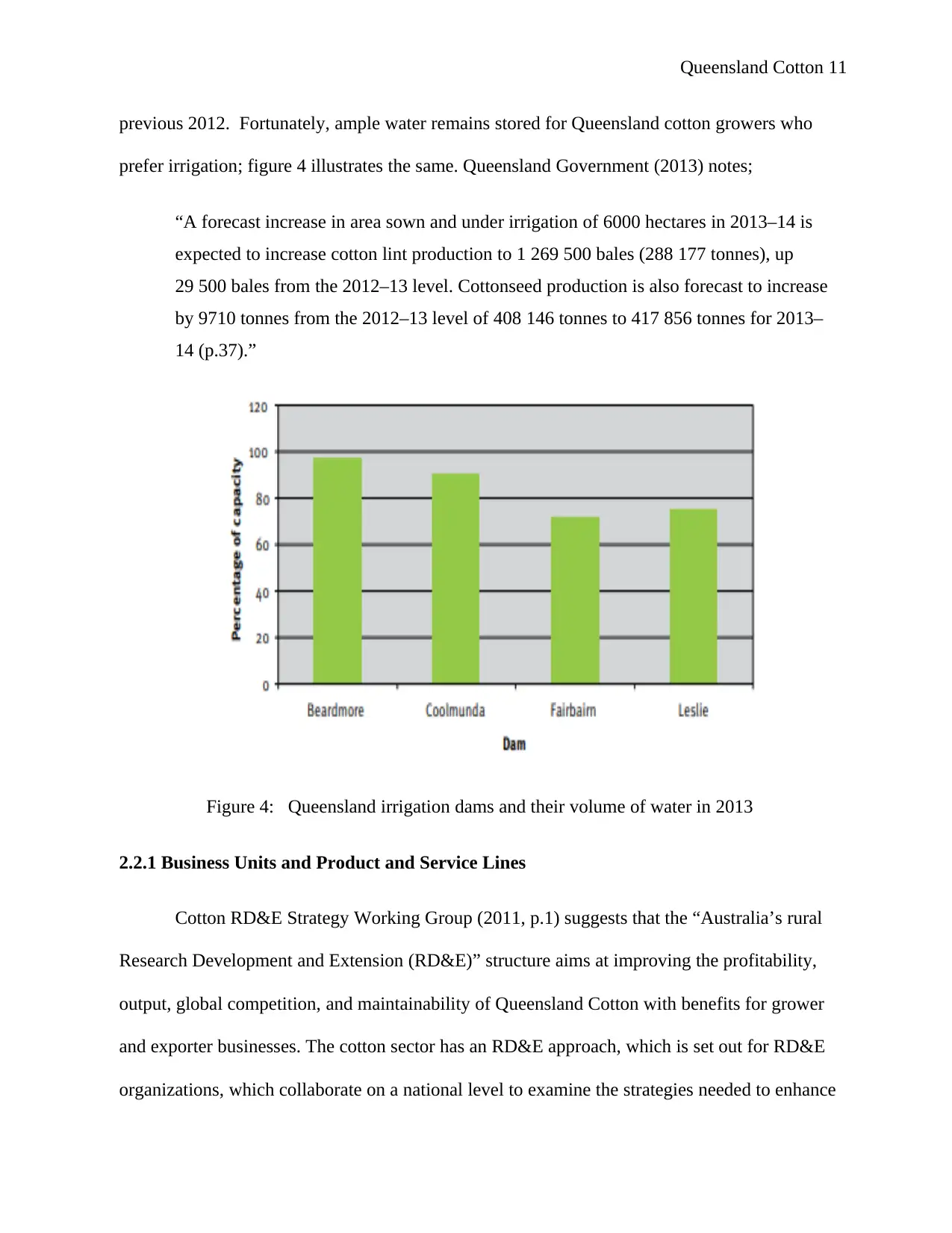
Queensland Cotton 11
previous 2012. Fortunately, ample water remains stored for Queensland cotton growers who
prefer irrigation; figure 4 illustrates the same. Queensland Government (2013) notes;
“A forecast increase in area sown and under irrigation of 6000 hectares in 2013–14 is
expected to increase cotton lint production to 1 269 500 bales (288 177 tonnes), up
29 500 bales from the 2012–13 level. Cottonseed production is also forecast to increase
by 9710 tonnes from the 2012–13 level of 408 146 tonnes to 417 856 tonnes for 2013–
14 (p.37).”
Figure 4: Queensland irrigation dams and their volume of water in 2013
2.2.1 Business Units and Product and Service Lines
Cotton RD&E Strategy Working Group (2011, p.1) suggests that the “Australia’s rural
Research Development and Extension (RD&E)” structure aims at improving the profitability,
output, global competition, and maintainability of Queensland Cotton with benefits for grower
and exporter businesses. The cotton sector has an RD&E approach, which is set out for RD&E
organizations, which collaborate on a national level to examine the strategies needed to enhance
previous 2012. Fortunately, ample water remains stored for Queensland cotton growers who
prefer irrigation; figure 4 illustrates the same. Queensland Government (2013) notes;
“A forecast increase in area sown and under irrigation of 6000 hectares in 2013–14 is
expected to increase cotton lint production to 1 269 500 bales (288 177 tonnes), up
29 500 bales from the 2012–13 level. Cottonseed production is also forecast to increase
by 9710 tonnes from the 2012–13 level of 408 146 tonnes to 417 856 tonnes for 2013–
14 (p.37).”
Figure 4: Queensland irrigation dams and their volume of water in 2013
2.2.1 Business Units and Product and Service Lines
Cotton RD&E Strategy Working Group (2011, p.1) suggests that the “Australia’s rural
Research Development and Extension (RD&E)” structure aims at improving the profitability,
output, global competition, and maintainability of Queensland Cotton with benefits for grower
and exporter businesses. The cotton sector has an RD&E approach, which is set out for RD&E
organizations, which collaborate on a national level to examine the strategies needed to enhance
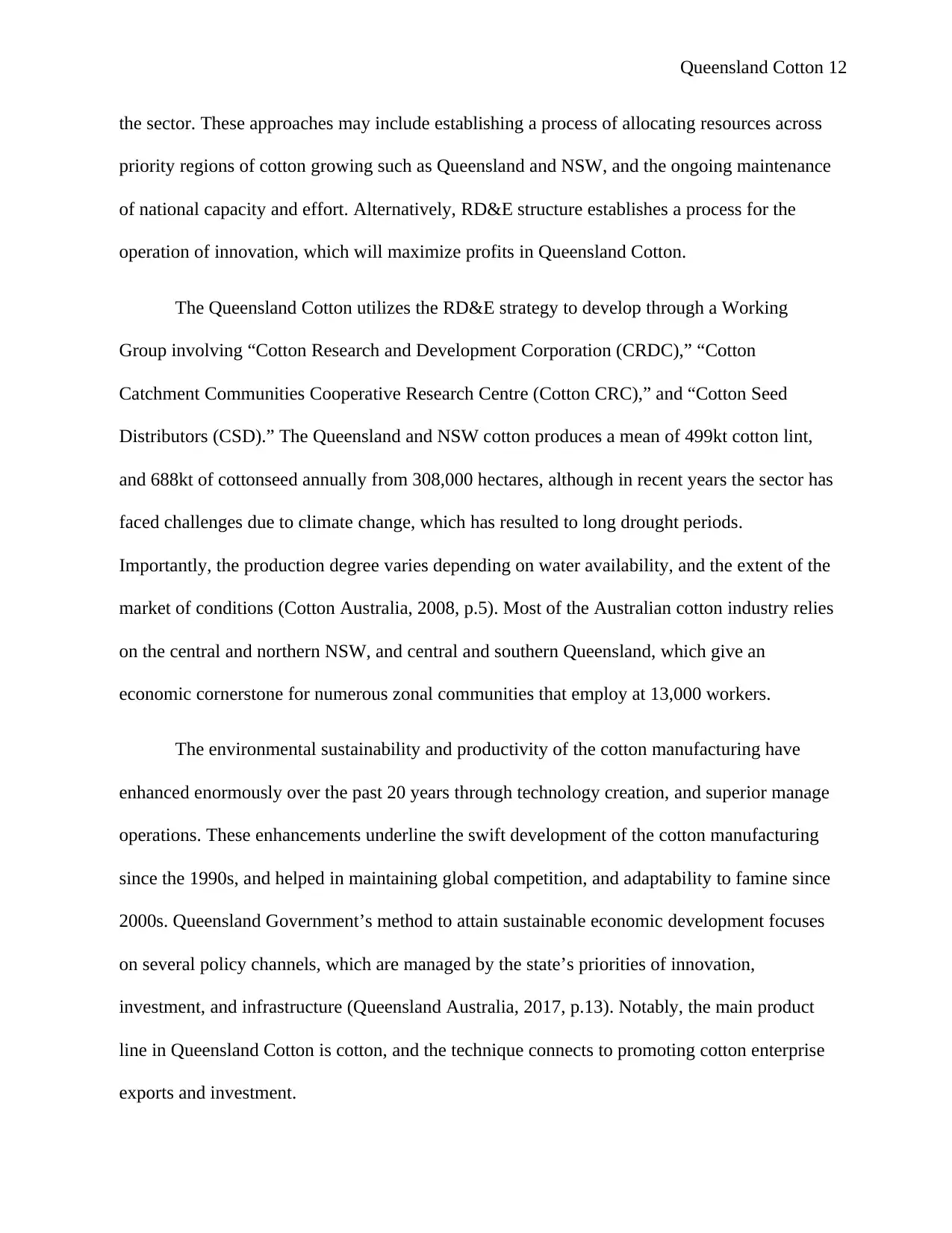
Queensland Cotton 12
the sector. These approaches may include establishing a process of allocating resources across
priority regions of cotton growing such as Queensland and NSW, and the ongoing maintenance
of national capacity and effort. Alternatively, RD&E structure establishes a process for the
operation of innovation, which will maximize profits in Queensland Cotton.
The Queensland Cotton utilizes the RD&E strategy to develop through a Working
Group involving “Cotton Research and Development Corporation (CRDC),” “Cotton
Catchment Communities Cooperative Research Centre (Cotton CRC),” and “Cotton Seed
Distributors (CSD).” The Queensland and NSW cotton produces a mean of 499kt cotton lint,
and 688kt of cottonseed annually from 308,000 hectares, although in recent years the sector has
faced challenges due to climate change, which has resulted to long drought periods.
Importantly, the production degree varies depending on water availability, and the extent of the
market of conditions (Cotton Australia, 2008, p.5). Most of the Australian cotton industry relies
on the central and northern NSW, and central and southern Queensland, which give an
economic cornerstone for numerous zonal communities that employ at 13,000 workers.
The environmental sustainability and productivity of the cotton manufacturing have
enhanced enormously over the past 20 years through technology creation, and superior manage
operations. These enhancements underline the swift development of the cotton manufacturing
since the 1990s, and helped in maintaining global competition, and adaptability to famine since
2000s. Queensland Government’s method to attain sustainable economic development focuses
on several policy channels, which are managed by the state’s priorities of innovation,
investment, and infrastructure (Queensland Australia, 2017, p.13). Notably, the main product
line in Queensland Cotton is cotton, and the technique connects to promoting cotton enterprise
exports and investment.
the sector. These approaches may include establishing a process of allocating resources across
priority regions of cotton growing such as Queensland and NSW, and the ongoing maintenance
of national capacity and effort. Alternatively, RD&E structure establishes a process for the
operation of innovation, which will maximize profits in Queensland Cotton.
The Queensland Cotton utilizes the RD&E strategy to develop through a Working
Group involving “Cotton Research and Development Corporation (CRDC),” “Cotton
Catchment Communities Cooperative Research Centre (Cotton CRC),” and “Cotton Seed
Distributors (CSD).” The Queensland and NSW cotton produces a mean of 499kt cotton lint,
and 688kt of cottonseed annually from 308,000 hectares, although in recent years the sector has
faced challenges due to climate change, which has resulted to long drought periods.
Importantly, the production degree varies depending on water availability, and the extent of the
market of conditions (Cotton Australia, 2008, p.5). Most of the Australian cotton industry relies
on the central and northern NSW, and central and southern Queensland, which give an
economic cornerstone for numerous zonal communities that employ at 13,000 workers.
The environmental sustainability and productivity of the cotton manufacturing have
enhanced enormously over the past 20 years through technology creation, and superior manage
operations. These enhancements underline the swift development of the cotton manufacturing
since the 1990s, and helped in maintaining global competition, and adaptability to famine since
2000s. Queensland Government’s method to attain sustainable economic development focuses
on several policy channels, which are managed by the state’s priorities of innovation,
investment, and infrastructure (Queensland Australia, 2017, p.13). Notably, the main product
line in Queensland Cotton is cotton, and the technique connects to promoting cotton enterprise
exports and investment.
⊘ This is a preview!⊘
Do you want full access?
Subscribe today to unlock all pages.

Trusted by 1+ million students worldwide
1 out of 35
Related Documents
Your All-in-One AI-Powered Toolkit for Academic Success.
+13062052269
info@desklib.com
Available 24*7 on WhatsApp / Email
![[object Object]](/_next/static/media/star-bottom.7253800d.svg)
Unlock your academic potential
Copyright © 2020–2025 A2Z Services. All Rights Reserved. Developed and managed by ZUCOL.




